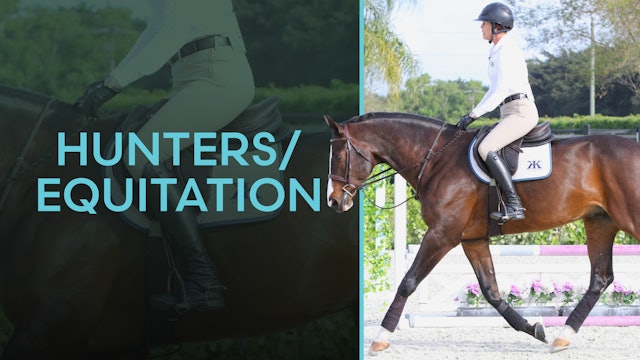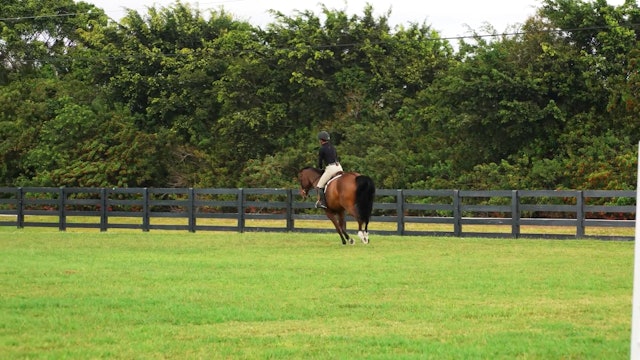Hunters/Equitation
Modern hunter classes were designed to test the qualities and attributes of a successful hunt horse negotiating natural obstacles (fences, hedges, stone walls). These classes are subjectively judged based on the horse’s performance over fences as well as its quality of movement under saddle on the flat.
Equitation classes are judged on the rider’s ability, form and skill to allow the horse to perform at its best, but the horse itself is not judged at all. The judging is subjectively based on the rider’s position, style, proficiency, accuracy, use of the aids, as well as an overall impression of complete and quiet control. Search for your favorite coach or by training topic.
-
Behind-the-Scenes Q&A | Geoffrey Hesslink
During our video shoot at Geoffrey Hesslink’s stunning facility in Wellington, Florida, we got the opportunity to sit down with him for a one-on-one Q&A. The hunter/jumper trainer talks about his horses’ fitness and training routines, his teaching philosophy and how he strives to instill confiden...
-
Execute Proper Hunter Lines | Geoffrey Hesslink
Top hunter rider Geoffrey Hesslink demonstrates how to ride seamless hunter lines that are both smooth and flowing with minimal rider aids to achieve the highest score possible. He also explains how to measure, get down and find the end of hunter lines by using all the space in your arena and not...
-
Adding Strides and Changing Tracks for Hunter Success | Geoffrey Hesslink
Top hunter rider Geoffrey Hesslink demonstrates an exercise involving three small cavalletti set up on a slight curve that he has his students drill to help them better understand how their track, pace and momentum affect distances and carry over to the show ring. As he rides the curve, Geoffrey ...
-
Gymnastic Exercises to Improve Your Hunter Rounds | Geoffrey Hesslink
Top hunter rider Geoffrey Hesslink demonstrates a combination of gymnastic exercises that he regularly works into his horses’ training routines to improve straightness, fitness and help build up strength in their hindquarters. He explains how these exercises can also help young or less experience...
-
Effective Rider Aids - Figure-Eight Exercise | Holly Hugo-Vidal | PART 03
Holly Hugo-Vidal shares a figure-eight track riding exercise on the flat and then over a fence, with the goal of riding a precise track and maintaining a rhythm using both reins and legs.
-
Effective Rider Aids - Horse in Front of the Leg | Holly Hugo-Vidal | PART 02
Holly Hugo-Vidal explains the importance of having a horse in front of the leg and shows what it looks like to have a horse in front of the leg and behind the leg. She then explains how to correct a horse that is behind the leg in the walk, trot, canter and over fences.
-
Effective Rider Aids - Position for Correct Aids | Holly Hugo-Vidal | PART 01
Holly Hugo-Vidal explains correct rider position and how to properly coordinate your leg and hand aids and apply them on the flat and over fences. She then explains how to ride different lines and finally, puts a course together.
-
Riding the Bending Line | Holly Hugo-Vidal
Holly explains how a rider uses her eyes to determine where the track in the bending line needs to be in order to ride it in an even six strides. She explains how riding different tracks to the first fence affects how much bend between the two fences is needed.
-
Walking a Line | Holly Hugo-Vidal
Holly shows how to determine the number of strides a horse should take in a straight line and a bending line. She walks a straight line in seven strides and then a bending line in six strides. She also discusses how position adjustments can help the horse land on a particular lead in the bending ...
-
Seeing a Distance - Rhythm Over a Ground Pole | Holly Hugo-Vidal | PART 02
Building on the exercises in Part 1, Holly explains why bad distances happen. For the final exercise in the series, she has the rider approach a vertical in a good rhythm and balance, and when the horse has focused on it, she has the rider look at her raised hand, concentrating on maintaining the...
-
Riding on Sand vs. Riding on Grass | Kristy Herrera
Kristy explains and demonstrates how riding and jumping a horse in a grass arena can be different compared to riding and jumping in a sand, or similar type of footing, arena. A traditional arena is typically level and fairly similar from arena to arena. Grass arenas can vary widely depending on t...
-
Geoff Teall – 3’ Level – Jumping a Short Course – Part 3
Geoff Teall finishes this group’s lesson with an exercise on looking around the circle on a jump and looking ahead to the next line. The purpose is to stay balanced and go with the horse while keeping the turns smooth and relaxed.
-
Geoff Teall – 3’ Level – Jumping a Short Course – Part 2
The horses are having a harder time stopping after a line of two jumps so Geoff Teall suggests an exercise to work on that. The more the riders slow down going into the line, the better chance they have of stopping after the line. Repetition also helps to steady the horses.
-
Geoff Teall – 3’ Level – Jumping a Short Course – Part 1
Geoff Teall sets a course for the clinic riders and wants them to make the decisions of where and when they need to stop to bring their horses back. The pace should be forward but steady and the lines should stay straight, but the choice as to what to do will come after the jump. He stresses abou...
-
Geoff Teall – 3’ Level – Warm-up on the Flat – Part 2
Geoff Teall talks about the importance of a straight line from the clinic riders’ hands to the horses’ mouths. The purpose of this is to establish a nice contact with the horse’s mouth. This can also help improve the horse’s suppleness. While the position change may be minimal, the result is sign...
-
Geoff Teall – 3’ Level – Warm-up on the Flat – Part 1
Geoff Teall has the clinic horses start in a posting trot, which he says is a good gait to get a read on how the horses feel that day. The horses have to be willing to carry the riders in a relaxed, forward manner. Both horses and riders need to be comfortable working at the pace needed to jump s...
-
Geoff Teall – 2’6” to 2’9” – Ground Rails and Jumps
With the clinic horses settled, Geoff Teall keeps the ground rails, but adds a few jumps to see how the horses react. The rails with the jumps helps the horses to balance better, slow down and collect to add a stride in a line.
-
Geoff Teall – 2’6” to 2’9” – Working with Ground Rails
Because the clinic horses were getting too strong, Geoff Teall changed his original plan and had the riders work their horses over ground rails. Walking and trotting over poles helps settle the horses and make it easier to bring them back quietly.
-
Geoff Teall – 2’6” to 2’9” – Jumping a Short Course
Geoff Teall sets a course for the clinic riders and wants them to make the decisions of where and when they need to stop in order to bring their horses back. The pace should stay about the same and the lines should stay straight, but the choice as to what to do next will come after the jump.
-
Geoff Teall – 2’6” to 2’9” – Warm-up on the Flat – Part 2
Riders in the Geoff Teall clinic continue in a slow hand-gallop and work toward establishing the canter needed to jump. The riders need to be in a half-seat with balance in the legs while the hands are steady and even. They fine-tune their positions on the flat so they are better prepared to star...
-
Geoff Teall – 2’6” to 2’9” – Warm-up on the Flat – Part 1
Geoff Teall has the horses start in a posting trot, which he says is a good gait to get a read on how the horses feel that day. The horses have to be willing to carry the riders in a relaxed, forward manner. Both horses and riders should be comfortable working at the pace needed to jump.
-
Geoff Teall – 2’ to 2’3” – Jumping a Short Course – Part 2
The clinic riders repeat the course adding small details, such as a quicker pace or shorter reins, to make the rounds even smoother. At the end of the session, Geoff Teall has the riders talk about what they learned over the three days.
-
Geoff Teall – 2’ to 2’3” – Jumping a Short Course – Part 1
Geoff Teall sets a course for the clinic riders and wants them to make the decision of where and when they need to stop in order to bring their horses back. The pace should stay about the same and the lines should stay straight, but the choice as to what to do will come after the jump.
-
Geoff Teall – 2’ to 2’3” – Settling a Horse that Rushes
Geoff Teall has clinic riders canter a fence, stop straight, back up a couple of steps, turn to the outside, circle and then canter the same jump in the opposite direction. This exercise is excellent for horses that tend to rush. He’s looking for a slow, steady rhythm from the horses and a light ...


























